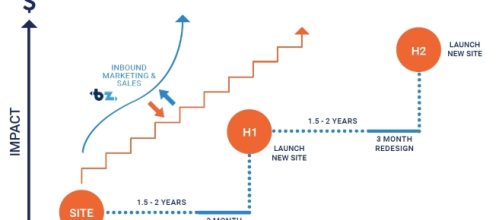When it comes to Website Design, many people think that they are living the 90s Blockbuster fantasy-drama ‘Field of Dreams’. ‘If you build it, he will come’. Just like Ray Kinsella builds a backyard baseball field to attract the ghosts of former players, if you build a website you’ll attract customers, magically. Not just that, but your customers will easily find what they are looking for, will have a great experience finding it, will get the desired value out of it, magically. That’s the traditional approach to website design and it’s broken. Why?
Simply because it’s more wishful thinking than reality as nothing in this world happens on its own, you have to make it happen.
Growth-driven Design by Hubspot is a methodology that minimizes all the risks that are involved in the traditional approach. But many folks are still into the traditional approach, why? Simply because they think this is the way things are, and they don’t have any choice. They are not aware of the alternative that now exists, thanks to Hubspot. Lo and behold, the Growth-driven Design methodology.
'Groundhog Day' is a perfect guide to website design
We are actually living another 90s Blockbuster ‘groundhog day’. Folks, the Growth-driven Design Methodology requires all of us to walk in the shoes of Phil Connors, the protagonist of the movie and replicate exactly what he does to achieve our business and marketing goals.
So let's examine closely what Phil Connors does in the movie.
In the Groundhog Day movie, the day’s events repeat exactly as before in the world of website design and management. For instance, visitors are coming to your website every day, they are consuming your content every day, and they are finding your offer relevant to their needs and goals every day, they are clicking on the same CTAs every day, and so on and so forth.
Now, in reality, people who are not aware of GDD methodology are living the 90s blockbuster ‘field of dreams’, when their website doesn’t add value to their business it’s like a nightmare for them. When they wake up in the morning, they take it as a bad dream and returns to bed the following night, only to wake up the next day to relive it.
The traditional website design causes them to trap in a time loop that they themselves are not seemingly aware of. 2-3 years pass by since the last website redesign and their website and it stops responding to the changing needs of customers, thus becomes less and less relevant to their business goals. As a result, their websites become more of a liability for their business than an asset, something that makes them depressed just like Phil and they become desperate to end the loop (Phil even committed suicide in one of the loops to end the loop just to wake up on the Groundhog Day again in the morning).
The solution
The solution lies in doing exactly what Phil does, the solution lies in the GDD Methodology.
Phil memorizes all the events and actions of the various townsfolk he meets in the loop every day, and then use his knowledge of those events to try to better himself, as well as the lives of the townsfolk. You have to gather data on your website about your visitors, how they end up on your website, what they do when they are on your website, their behavior and interests using their activity on your website and then use it to better yourself and the lives of your customers.
Having real user data will allow you to mold your website according to the needs and interests of your visitors and helps you turning them into a life-long customer. You’ll deliver the value they are looking for, and they’ll happily pay you the money you are looking for.
More importantly, it will allow you to avoid accidents and disastrous situations (dissatisfied customers and lost business) just like Phil that otherwise would have occurred. Eventually, Phil succeeds in escaping the loop by transforming himself into a more empathetic and helpful person, something you are supposed to do as a business.

